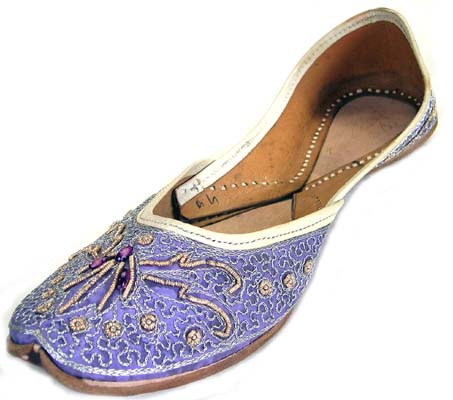 Search | About Us | Guest Book
Search | About Us | Guest Book
|
Indian Ethnic Footwear Industry Click here to view Case Study on Kolhapuri Chappals Most of the leather firms are in the unorganized sector. The small-scale industries, cottage and artisans sector follows old and traditional methods of manufacture. As production processes are traditional product quality cannot meet the international standard. The low quality product with limited variety has made many of the Indian leather units non-competitive. Given the nature of the leather industry, modernization of leather industry requires the following initiatives to make it efficient, agile, responsive, and competitive, namely: Ethnic footwear is sub-sector of leather products, which includes hand-crafted footwear produced by artisans and traditional families. These are ethnic/ traditional in nature as it encapsulates craftsmanship passed on from generation to generation to generation to artisans and also manifest cultural diversity of different regions. The special natures of artisan products have distinctive features, i.e., aesthetic, artistic, creative, culturally attached, decorative, functional, traditional, religiously and socially symbolic and significant. In the case of traditional/ ethnic or handcrafted footwear, vegetable tanned leather is utilized. There is a variety of ethnic footwear being produced in different parts of the nation. Hence, no need to say, their looks, features, religious & social significance, etc. varies from region to region. Major ethnic footwear according to their production regions are discussed below:
But today, ethnic footwear industry in India is in a quite miserable state. Lack of standardization, product deficiencies, lack of innovative and improved designs, competition from organized and cheap footwear producing firms, lack of proper marketing channels, etc. are a few causes of the problems being faced by the Indian ethnic footwear industry. Change of profession by the artisans is too a major cause. Even the artisans not at all welcome major and complicated changes as it completely upsets their work culture.We begin our discussion over Indian ethnic footwears with Punjabi Jootis/ Juttis and Rajasthani Mojaris. Believed to be inspired from Mughal period, Juttis are handmade by skilled artisans. Characterised by its flat leather sole, the slip-on Juttis or Mojari rises high to the Achilles tendon in the back and covers the toes with a round structure. The heavily embroidered leather/ raw silk uppers, lots of artistic patterns with precious/ semi-precious stones an d bead embellishments are its unique features. As far as comfort is concerned, these Juttis/ Mojaris keep feet cool in hot season and hot in winters.Another unique ethnic footwear being solely produced in India is Kolhapuris. This unique footwear which has carved a niche for itself in not only trade fairs, but has also found preference among foreign tourists who are well familiar with this natural, rugged, attractive footwear due to its introduction and familiarity in their own countries. The art has been handed down from generation to generation. The manufacture of Kolhapuri footwear from tanned leather is a traditional occupation that has assumed the proportions of a cottage industry with hundreds of families being involved in this vocation. In Athani, for example, there are over five hundred families involved in footwear manufacture. Every member of the household contributes to the process by being involved in any of the following activities like cutting the leather, dipping it in water for soaking, stitching the ‘patta’ or weaving the ‘veni’. The jobs are clearly divided within the family with the men doing the cutting, the women doing the stitching while children weaving the ‘veni’. The entire family works laboriously and produces approximately 35 to 45 pairs of Kolhapuri chappals per week.If we go the higher reaches of Himanchal Pradesh, there come straw and threated bark shoes or Phullas used for walking on snow. Each Phulla is made in one piece with its bark sole providing excellent grip on snow. In addition, Chamba town in Himanchal Pradesh is known for the design quality of its leather chappals. Besides their aesthetic appeal, they are light and comfortable. So these were some of the ethnic footwear being produced by Small Scale Industries (SSI) units in India. Move to other sections of this portal to know more.
|
 · Enhance productivity· Reduce wastage· Increase the product design· Automate the production process
· Enhance productivity· Reduce wastage· Increase the product design· Automate the production process